

To understand the Yoga Meditation exercises in this book in all their aspects – physical, mental and spiritual – it is first helpful to have some knowledge and understanding of your subtle anatomy. The more you become aware of this internal energy system and can direct your own essential life-force efficiently, not only as you practise the exercises in this book but also as you go about your daily life, the more control you will enjoy over your own health and happiness.
In this chapter, we explore this energy system, including:
• the physical body, the two subtle bodies and their five sheaths (koshas) – the subtle bodies and sheaths sustain the physical body with energy, just as electricity powers light within a light bulb
• the chakras – the body’s seven main energy centres serve as transformers to receive, assimilate and distribute the vital energy, or life-force, required for the body’s systems to function
• the nadis – subtle energy channels running throughout the body transport the body’s life-force, nourishing you with vitality
• kundalini – spiritual energy, or consciousness, which is symbolized as a coiled-up serpent living in a latent form at the base of the spine.
We are spiritual beings, immortal spirit-souls temporarily embodied in both material fields of energy (our physical body) and non-material fields of energy (“subtle bodies” that are invisible to the naked eye).
These subtle bodies interpenetrate and surround our physical body in two layers, known as the astral and the causal body.
The body in which our true self or soul (atman or purusha) resides can therefore be likened to a castle that has three layers of fortification:
• the physical body (sthula sharira) – the inner “wall”, which is subject to the limits of time, space and gravity, and is destroyed upon death
• the astral body (suksma sharira) – the middle “wall”, which is more durable
• the causal body (karana sharira) – the outer “wall”, which is even more permanent, being carried through countless lifetimes.
There are also what is known as five “sheaths” (koshas), which are located within the three bodies. These are called sheaths because they are like coverings of the inner luminous self, just as a light bulb is covered by a lampshade. Although we experience the action of these sheaths as if they are a reality that make up our personality, they – along with the three bodies – have, in fact, no permanent reality. They are mere vehicles for the expression of the true self (atman), which lies distinct from them all and which we aim to find through the Yoga Meditation practices in this book.
While we need to keep each of the bodies and sheaths in optimal working order so that we remain healthy and vital, we should also aim to stop associating their actions with our limited sense of self, and instead start identifying with the true, divine self that lies beyond, where we will find deep inner peace and contentment.

This image depicts the physical body (from which the golden glow of the soul, or atman, shines out) surrounded by the astral (yellow) and causal (green) bodies.
“The physical sheath is filled by the vital sheath, the vital sheath by the mental sheath, the mental sheath by the intelligent sheath, and the intelligent sheath by the blissful sheath.”
Taittiriya Upanishad
The most concrete of the three bodies, the physical body is subject to birth, growth, disease, decay and death. The most effective way to keep this body healthy and vital is not only through a balanced diet and physical exercise such as running and swimming, but also through yoga postures (asana) to balance our energy, breathing techniques (pranayama) to clear the energy channels, and meditation to give rest to our mind and body.
The physical body has only one sheath, known as the annamaya kosha, or “food sheath”, because of its dependence on life-force (prana) manifested in the forms of food, water and air. It sustains our physical existence.
The astral body – the invisible fortifying wall surrounding the physical body – is the home of our personality, our thoughts and our feelings; in short, all our non-physical personal attributes. This body could be described as the “conductor” of the physical body, as all our physical actions take place as a result of the astral body’s energy (the physical body does not have the required energy of its own). The most effective way to energize and empower this body is through practising yoga asana, pranayama, mantra chanting (see page 112), self-enquiry and the study of yogic scriptures.
The astral body contains three sheaths: pranamaya kosha, manomaya kosha and vijnanamaya kosha (see below).
This sheath supplies our life-energy, or prana, to the physical body, as well as controlling the organs of action (the hands, feet, tongue, genitals and anus), and governing how we react to the world.
This is our mental and emotional layer, enabling us to experience our thoughts and feelings. Subtler than the food sheath and vital air sheath, the mind sheath communicates our thoughts and feelings to the physical body, which reacts accordingly. It also communicates our sensations of the external world, such as thirst or heat, to the intelligence sheath (see below) so that decisions can be taken on what to do about them. As such, it is a vital communicator. We can strengthen and purify this mind sheath by following certain pranayama and meditation practices.
This layer obtains knowledge through thought, experience and the senses. As such, it functions as the knower and the doer of the astral body, making decisions, choices and value-judgments. As well as being home to our intellect, this is where our ego resides – our strong sense of “I” and “my”, which is what separates us from identifying with universal consciousness and finding our true, joyful inner self. To strive on a spiritual path, it is therefore important to aim to purify the ego and hone the intellect.
Even more subtle than the astral body, the causal body is composed of our deepest thoughts, desires, intentions and aspirations. It is the storehouse of our past impressions, the seed impressions that motivate our behaviour and create our karma. In the analogy of the three-walled castle, the causal body is the wall connecting us to the divine self. Although it gives light and energy to the astral body, its own vitality has a different abode, called the anandamaya kosha (bliss sheath). This is a body of light that reflects the blissfulness of the self, allowing us to experience true joy.
Chakra is a Sanskrit word meaning “wheel” or “revolving disc”. Accordingly, chakras in the human body are thought to be wheels or revolving discs of subtle energy or life-force (prana) located along the midline of the astral body, known as the astral spine. They are confluences of consciousness and energy that store and distribute energy and information to the physical body, as well as storing our psychological tendencies, desires and habits.
The yoga tradition recognizes seven major chakras distributed along the midline of the body. These are located:
• at the base of the spine – muladhara
• in the genital area – svadhisthana
• at the navel – manipura
• at chest or heart level – anahata
• at the throat – vishuddhi
• at the forehead – ajna
• above the crown of the head – sahasrara
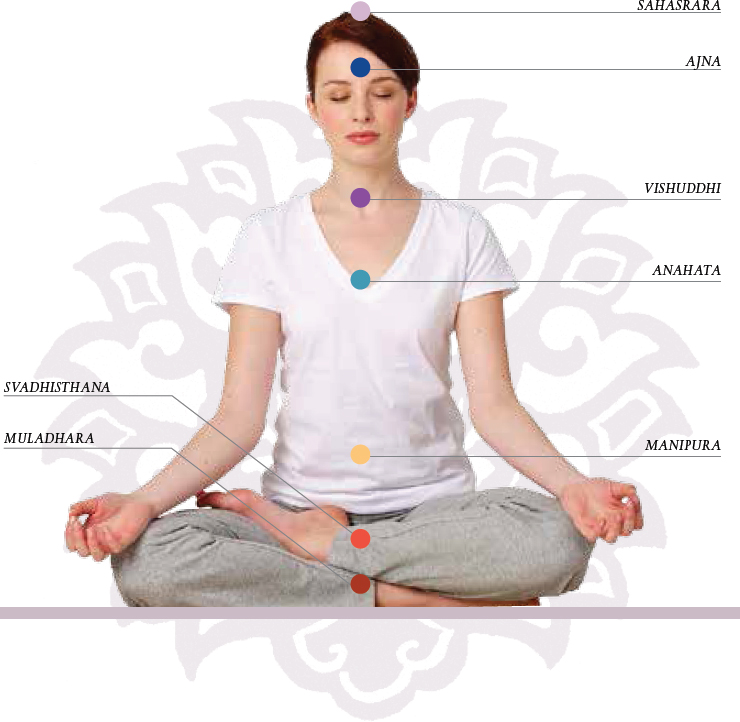
It is essential for these chakras to be functioning well in order to store the maximum energy that can be used by the body at will. Just like, over a period of time, the battery of a car can become old and lose its capacity to “hold charge” if not well looked after, so too will your chakras become unable to adequately support the vital systems of the body if they are not sufficiently developed. Regular practice of the yoga exercises in the pages that follow, such as asanas, pranayama and chanting the bija mantras (see pages 118–9), will ensure their balanced development, and therefore boost energy levels and enhance overall health.

Visual representation of the chakras
According to yogis, healers and psychics who are able actually to see human energy fields, chakras are colourful, fast-moving whirlpools, each one taking the form of a funnel-shaped structure, somewhat like a convolvulus flower. They are often symbolized by diagrams in the form of lotus flowers (padmas), each one with specific numbers of petals, colours, seed-syllable (bija) mantras and other symbols and deities within them. These images are visual representations of the chakras’ energetic experiences (see chart on page 41) and can help meditators to achieve concentration of the mind. The colours of the chakras here do not tally with the Western New Age tradition but correspond to the yogic tantric tradition as elucidated by Swami Satyananda Saraswati (1923–2009).
Ultimately, our bodies are nothing but energy. Our chakras act as dynamos of cosmic energy, allowing our subtle bodies to plug into the universal power source. They serve as transformers and regulators to receive, assimilate and distribute prana in the astral body, which then distributes it to the spinal nerve plexuses, where it is, in turn, transferred to the blood and organs of the physical body.
The prana enters the body at the base of the brain (an area known as the medulla oblongata) and flows to the higher brain centres. It then filters downward through the six major chakras below that, starting at ajna chakra and working its way down to muladhara chakra; sahasrara, the main generator of the energies that power these six chakras, is located at the crown, above the medulla oblongata, and operates on a higher plane of consciousness.
As this energy spirals down through each chakra, it becomes increasingly dense, until it forms what are known as the five great elements (panchamahabhuta). These are essential “states” of matter, not to be confused with the periodic elements of modern chemistry, and they represent the stages of creation from spirit to matter.
• From the unmanifested state of universal consciousness came the subtle, primal sound vibration Om. From the subtle vibration of Om came the ether or space element – associated with vishuddhi chakra.
• The light and expansive movements of the ether element created the air element – associated with anahata chakra.
• The movement of air created friction, which generated heat particles forming intense light, from which the fire element was created – associated with manipura chakra.
• The heat of the fire liquefied certain ethereal elements that formed the water element – associated with svadhisthana chakra.
• Finally, the water solidified to form the earth element – associated with muladhara chakra.
Thus, the five building blocks of matter – ether, air, fire, water and earth – came into existence. These five elements, which are present in all matter, also exist within each of us. For example, in our body, the source of fire is metabolism – it activates our digestion and also activates our eyes to see light. The difference between the different elements in our body lies in their vibratory wavelength frequencies. The lower chakras, connected with basic survival and groundedness, vibrate at a denser frequency than the higher chakras, associated with spiritual enlightenment.
The underlying aim of the Yoga Meditation practices in this book is a reversal of the soul’s descent into matter – back to divine oneness in pure consciousness, as it is only once this has been achieved that we can experience our true inner stillness and bliss. When your mind is calm and still, you become aware of your true identity, of the spiritual being within yourself who is beyond the forces of the body, mind and senses. Yoga Meditation is an effort to perceive this presence of cosmic energy and pure consciousness.
“The conscious cosmic energy first enters through the medulla oblongata (in the brain stem) and remains concentrated in the brain as the thousand-petalled lotus. Then it descends into the body through the spinal cord and sympathetic nervous system.”
Paramhansa Yogananda
Below is an overview of each chakra, the nature of its energy, and how that energy governs a certain aspect of our being, as well as insight into how each chakra fits into the Yoga Meditation journey in terms of raising our consciousness to a higher realm in our quest to discover our true, joyful inner self.

Also referred to as the “base” chakra, muladhara chakra – located between the origin of the reproductive organ and the anus – is the foundation of our personality. When fully functioning, this chakra gives us a sense of groundedness and deep-seated security in life. It is also where kundalini energy (see pages 46–7) resides and is therefore the basis from which the possibility of higher realization arises: the upward journey of kundalini energy to sahasrara chakra, at the crown of the head, starts here, once it has been awakened through Yoga Meditation practices.
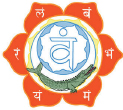
Next on the journey up toward spiritual awakening is the fluid and adaptive svadhisthana chakra – located in the sacral region of the spine at the level of the coccyx (tailbone) – from where we can start to express ourselves creatively and sensually. When functioning well, this chakra gives us the ability to go with the flow and enjoy all that life has to offer.
The Sanskrit word sva means “one’s own” and adhisthana means “dwelling place”, so svadhisthana means “one’s own dwelling place”. It has been suggested by some yogis that this refers to a distant time when the seat of kundalini lay dormant within svadhisthana chakra, but for some reason kundalini has since come to rest in muladhara chakra.
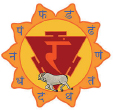
Next we come to manipura chakra, which is said to radiate its fiery energy like a bright sun. It is located at the level of the navel in the astral spine. Manipura is a very important centre because it is the centre of willpower, energy, vitality and achievement. It generates and distributes prana throughout the whole body, and controls our energy, balance and strength. So when it is in balance, we will feel strong, self-confident, empowered and vibrant.
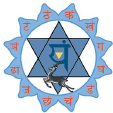
Next, we ascend to anahata chakra. Also called the heart chakra due to its location, this functions as a bridge between the three lower chakras – related to the world of body, mind and senses and associated with survival and security (muladhara chakra), sensuality and sex (svadhisthana chakra), and a sense of identity and personal power (manipura chakra) – and the three higher chakras, associated with a higher and more evolved consciousness. The expansiveness of love and compassion in anahata draws us upward into the higher realms of consciousness. When this chakra is functioning well, we will feel great love and compassion in our life.
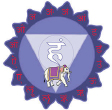
Located directly behind the base of the throat is vishuddhi chakra. The term vishuddhi is derived from the Sanskrit words visha, meaning “impurity”, and shuddhi, meaning “to purify”. It is our hub of communication, creativity, self-expression, non-attachment, and learning to accept and receive. When this chakra is balanced and open, our powers of communication and creativity become fully awakened. When kundalini energy reaches vishuddhi, we feel contentment, clarity of mind, a sense of understanding and non-attachment.

The Sanskrit word ajna literally means “to command”, “to obey” or “to know”. As such, this chakra – which is located on the forehead, between our eyebrows – is the command centre that guides the other chakras. Forming the boundary between human and divine consciousness, it represents a higher level of awareness and is considered the centre of extrasensory perception, intuition, clarity and wisdom.
Ajna chakra has two poles: a positive and a negative. The positive pole is the “spiritual eye”, which is located midway between the eyebrows, while the negative pole is at the medulla oblongata, which is located in the brain stem at the base of the skull and is the seat of the ego.
Ajna chakra is the meeting point of the three main energetic channels (the ida, pingala and sushumna nadis; see pages 42–5). When kundalini energy reaches this chakra, our awareness becomes concentrated and our ego-self is transcended. It is here that we experience realization of our true divine self.
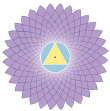
Also called niralambapuri, meaning “dwelling place without support”, and Brahmarandhra, “the door of God”, sahasrara chakra is the culmination of our ascent of the astral spine – after achieving self-realization at ajna, we achieve liberation at sahasrara. To reach this point, first we need to open, balance and energize the six chakras below it through deep meditation.
| LOCATION | POSITIVE QUALITIES | NEGATIVE QUALITIES | ELEMENT | |
SAHASRARA |
crown of head | beyond all duality, bliss | beyond all elements | |
AJNA |
centre of brain | selfless service, strong willpower, divine surrender | pride, excess intellect, strong sense of “I, me, mine” | mahat, i.e. mind, ego and intellect |
VISHUDDHI |
throat | expansiveness, sense of calm, silence | restlessness, boredom | ether |
ANAHATA |
heart | devotion, unconditional love, compassion | attachment, anger, rage, hatred | air |
MANIPURA |
navel | enthusiasm, confidence, effective leadership | misuse of power, ruthlessness | fire |
SVADHISTHANA |
sacrum | openness, willingness, intuition, creativity | indecision, vagueness | water |
MULADHARA |
perineum | courage, loyalty, steadfastness, perseverance | stubbornness, prejudice, intolerance | earth |
Within each of us lies a vast matrix of fine energetic channels called nadis (nadi literally means “flow” or “current”), which distribute our prana, or vital life-force throughout the body. These can be thought of as a network of interconnected rivers, streams and tributaries carrying energy to wherever it is needed. Indeed, the three main nadis (see below) are often symbolized by three of India’s great rivers: the ida by the Ganges, the pingala by the Yamuna, and the sushumna by the mythical Saraswati.
The source of the nadis is an egg-shaped centre of nerves called the kanda, which is located just above our lowest energy centre, muladhara chakra (see page 38). From here some 72,000 nadis are said to radiate out to form the entire subtle circuitry of the astral body.
Of the thousands of nadis, three stand out as the most important. These, as mentioned above, are:
• the sushumna – the central channel, which corresponds in position to both the physical and astral spine
• the ida – which begins on the left side of the sushumna
• the pingala – which begins on the right side of the sushumna.
The sushumna is criss-crossed in a helix by the ida and pingala, and the three channels converge at certain locations along the spine, into the whirling vortices that are the chakras (see page 45).
It is useful to know a little more about each of the three main nadis so that you have an idea of what is happening to you energetically not only as you go about your daily life, but also as you do the Yoga Meditation practices on the pages that follow.

There is a matrix of thousands of energetic channels, known as nadis, which comprise the subtle circuitry of the astral body.
The sushumna nadi (meaning “most gracious channel”) runs up the centre of the astral spine, which corresponds to the spinal cord in the physical body. This means that it passes through all the chakras in succession, from the base (muladhara) to the crown (sahasrara). While the ida and pingala nadis control our normal consciousness and are constantly active, even during sleep, the sushumna nadi is fully active only in people who are regularly engaged in spiritual practices such as Yoga Meditation. This is because it is only via such practices that balance can be achieved between ida and pingala energies, which, in turn, awakens the spiritual power known as kundalini (see pages 46–7), at the base of the spine, and sends it on its ascent along the sushumna. Also known as the Brahma nadi (“path to God”), the sushumna therefore provides the path to our spiritual awakening at sahasrara chakra: the place at which we can realize our true, joyful inner spirit and find the sense of inner calm for which we all search.
The ida and pingala nadis function alternately in the body, not simultaneously. This can be seen in the nostrils as we breathe. Generally, breath is flowing freely through one nostril while the other is blocked. This natural alternation occurs approximately every two hours.
When the left nostril is open, the ida nadi is flowing, the right hemisphere of the brain is active, the mind is introverted and creative, and the parasympathetic nervous system is active – responsible for resting the body when required.
When the right nostril is open, the pingala nadi is flowing, the left hemisphere of the brain is active, the mind is extroverted and logical, and the sympathetic nervous system is more active – responsible for stimulating urgent action when required.
The ida channel transports mental energy (chitta shakti) throughout the body and therefore controls all our psychological processes. The Sanskrit word ida actually means “comfort”, tying in with the notion of this channel being connected to the parasympathetic nervous system, which “comforts” and rests the body when it needs it. The ida is therefore associated with feminine, lunar energy, possessing cooling qualities.
Conversely, the right-hand pingala channel transports our vital life-force (prana) throughout the body and therefore controls all our physiological processes. The Sanskrit word pingala means “tawny-red”, which symbolizes this channel’s association with the stimulating energy of the sun and links it to the function of the sympathetic nervous system, which is there to stimulate action when required. The pingala is therefore linked with masculine, solar energy, possessing heating qualities.
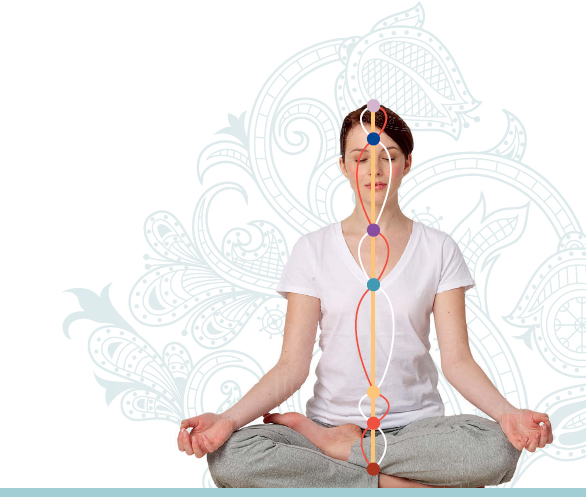
The ida and the pingala nadis criss-cross the central sushumna nadi, intersecting at chakras along the way.
Kundalini is the potential spiritual energy, or consciousness, that lies dormant at the base of the spine in the causal body (see page 33) of all beings. In reality, kundalini has no form, but as our mind requires a particular image on which to concentrate, kundalini has, in yogic theory, symbolically taken the form of a coiled serpent lying at the base of the spine (kundalini is derived from the Sanskrit term kundal, which means “coiled”).
Another association with the term kundalini is the Sanskrit word kunda, which means “cavity” and refers to the concave space in which the brain, resembling a coiled, sleeping serpent, nestles.
Kundalini takes two forms:
• pranic energy (prana shakti), which is the cause of all our actions
• spiritual energy or consciousness (caitanya shakti), which gives rise to our knowledge and wisdom.
When dedicated Yoga Meditation practice brings about balance between the upward movement of energy in the ida (accompanied by inhalation) and the downward movement of energy in the pingala (accompanied by exhalation), kundalini is activated from its dormant state in muladhara chakra. Both these currents of energy then move upward in the central channel of the sushumna, where they are activated in the brain, creating a sense of inner calm and divine joy as part of our spiritual awakening.
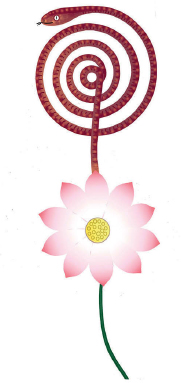
As the kundalini makes this spiritual ascent from muladhara chakra (root chakra) towards the sahasrara chakra (the seat of consciousness, at the crown of the head), it activates all the chakras in succession, causing layer after layer of the mind to become opened until the yogi experiences a sense of awakening, freedom, inner calm, bliss and, ultimately, a sense of unity with the world.
When, on the other hand, kundalini remains dormant at the base of the spine, and the energy flow in the spine is downward, toward the three lower chakras of worldly consciousness – which it is likely to be in people who are not regularly following any kind of spiritual practice – a person is likely to feel a lack of inner calm, joy and contentment due to the duality they experience between themselves and the world around them.
Alternatively, for people who have just started practising Yoga Meditation or who don’t yet do it regularly, there may only be a mild, or temporary, spiritual awakening – for example, in the lower three chakras. This would make them feel that there must be more to life than just eating, sleeping and sensual gratification (which operate in the three lower chakras). They are likely to be more aware that they are not just the body, mind and senses, but rather a spiritual being merely expressing themselves through these instruments.
However, regular practice of the pranayama exercises in chapter 6 will both purify and balance the nadis, increasing the chances of your experiencing the full potential and bliss of awakened kundalini.
“The kundalini, in its latent form, is coiled like a serpent. One who causes that shakti to move (from the muladhara upward) will attain liberation.”
Hatha Yoga Pradipika 3:108